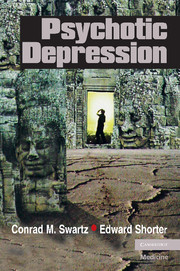Book contents
- Frontmatter
- Contents
- Preface
- Acknowledgments
- Chapter 1 Introduction
- Chapter 2 History of Psychotic Depression
- Chapter 3 Diagnosis in Psychotic Depression
- Chapter 4 Patients' Experience of Illness
- Chapter 5 Treatment in Historical Perspective
- Chapter 6 Treatment: Pitfalls and Pathways
- Chapter 7 Treatment: ECT, Medications, and More
- Chapter 8 Treatment by Type of Psychotic Depression
- Appendix 1 Summary Guide to Psychiatric Concepts
- Appendix 2 Summary Guide to Psychotropic Medication and Treatment
- References
- Index
Chapter 3 - Diagnosis in Psychotic Depression
Published online by Cambridge University Press: 10 September 2009
- Frontmatter
- Contents
- Preface
- Acknowledgments
- Chapter 1 Introduction
- Chapter 2 History of Psychotic Depression
- Chapter 3 Diagnosis in Psychotic Depression
- Chapter 4 Patients' Experience of Illness
- Chapter 5 Treatment in Historical Perspective
- Chapter 6 Treatment: Pitfalls and Pathways
- Chapter 7 Treatment: ECT, Medications, and More
- Chapter 8 Treatment by Type of Psychotic Depression
- Appendix 1 Summary Guide to Psychiatric Concepts
- Appendix 2 Summary Guide to Psychotropic Medication and Treatment
- References
- Index
Summary
How does one make the diagnosis of psychotic depression? How does one differentiate it from other conditions that may have similar symptoms?
Although psychotic depression is usually referred to as a single homogeneous entity, it has several different presentations. Each deserves a different treatment and thus constitutes a different type of psychotic depression. There are other conditions that only resemble psychotic depression and whose treatments differ still further again. Distinguishing among these types and conditions is the essence of proper diagnosis, and it is crucial to helping the patient and avoiding harm.
Problems with the DSM definition of psychotic depression
The first issue is how the diagnostic manual of the APA called DSM deals with psychotic depression. The DSM discusses this issue under the category “major depression.” If a patient has a DSM major depression, the formalities of psychotic depression are brief, and simply the presence of hallucinations or delusions will qualify the patient for this diagnosis. The DSM stipulates nothing about the contents, form, severity, intrusiveness, or behavioral effects of any hallucinations or delusions.
So, according to the DSM, psychotic depression is a major depression accompanied by hallucinations or delusions. Its formal and only name is “Major Depressive Episode, Severe With Psychotic Features.” It is classified as an episode that is symptomatic of an illness; the illness may be bipolar or unipolar, a single episode or recurrent.
- Type
- Chapter
- Information
- Psychotic Depression , pp. 59 - 127Publisher: Cambridge University PressPrint publication year: 2007
- 1
- Cited by



